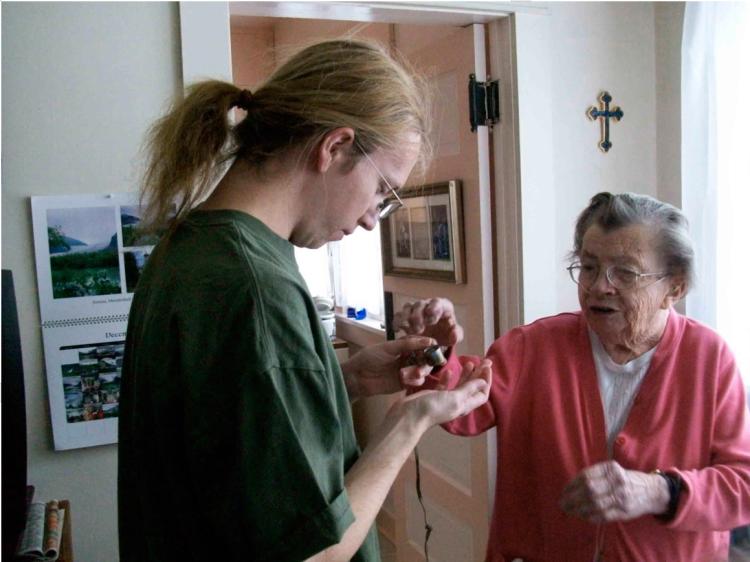Alumnus finds generational synchronicities in geology
Grandson following footsteps of legendary CU Boulder geologist Mary Oswald Griffitts
Daniel Griffitts (Geo’11) had been quietly volunteering with the paleontology collection at the University of Colorado Boulder for a long time before anyone realized he was the grandson of a legend, the late geologist Mary Oswald Griffitts.

The late Mary Oswald Griffitts, a notable geologist, quizzes her grandson, Daniel Griffitts, on mineral identification while he was an undergraduate at the University of Colorado Boulder. Photo courtesy of Daniel Griffitts.
“I didn’t bring it up, but (Emeritus Curator of Geology and Professor Emeritus of Natural History) Peter Robinson eventually figured it out. He knew my grandmother pretty well and recognized my name,” says Griffitts, who now works as a seasonal employee with the CU Museum of Natural History.
Mary Oswald Griffitts’ legacy extends beyond CU to the larger Boulder community and literally the farthest corner of the state. In 1944 she became the first woman to receive a PhD in geology at CU Boulder and two years later joined the faculty to teach historical geology and invertebrate paleontology.
She later helped found the Boulder Junior Natural Sciences School — a descendant of which continues today as the Thorne Nature Experience — and in 1981 began work on her detailed collection and cataloguing of the extensive fossil collection at Mesa Verde National Park. She retired at age 83, and following her death in 2010, the family established the Mary Oswald Griffitts Memorial Fund at CU.
“I remember she took me out when I was in kindergarten or first grade to look for fossils on land north of (Boulder),” Griffitts recalls. “I picked something up that didn’t look like anything, but there was a little fossil in it. She took it back to CU, where it was positively ID’d and put in the collection.”
Griffitts also vividly remembers the painting of Mesa Verde ruins that hung in his grandparents’ house, painted by his grandmother. Inspired by both his grandmother and grandfather, geologist Wallace R. Griffitts, Griffitts studied geology at CU Boulder. After graduating in 2011, he began working as a volunteer in the museum’s paleontology collection.
Toni Culver, former collections manager at the museum, soon recommended that the museum hire Griffitts to work on its innovative Fossils in the Classroom program, which produces a geology “unit in a box,” including 18 fossil specimens, lesson plans and support material, that is now being used in 580 Colorado public schools.
“Daniel, with his paleontology background, has been instrumental in quality control of the fossils and making sure the lessons are accurate. He’s a very important cog in the wheel, behind the scenes,” says Jim Hakala, senior educator at the CU museum.
Unbeknownst to Daniel, Hakala had his own memories of Mary Oswald Griffitts: As a young seasonal ranger at Mesa Verde in 1989, he endured her grueling, but informative, geology hikes at the park.
“It was part of our training, but those were the hardest days—long and hot, and the lectures were dry as toast,” he says. “Needless to say, she stuck in my mind!”

The late Mary Oswald Griffitts surveys the interior of a cliff dwelling at Mesa Verde National Park in 1986. Photo courtesy of Daniel Griffitts.
He didn’t realize, however, that his desert tutor was Mary Oswald Griffitts, the pioneering CU student and faculty member, until just last fall. That’s when he and several of his colleagues visited Mesa Verde as part of an ongoing collaborative research project between the park and museum. While walking through the ceramic and lithic collection, he came upon a color picture of the woman he remembered from those hot, dry lectures nearly three decades before.
“(Park staff) said, ‘Yeah, this collection is here because of what she did. We wouldn’t have any fossils if it weren’t for her,’” Hakala recalls.
And Hakala didn’t connect the dots between his former taskmaster and his young museum colleague until they’d been working together for five years. The big reveal came when Hakala mentioned he’d worked at the park as the two were driving to Longmont.
“I said, ‘Oh, my grandmother used to work at Mesa Verde,’” Griffitts says. “He said, ‘Oh, who was that?’ When I told him, it was, ‘Wow! Really?’”
Griffitts relishes coming across reminders of his grandmother in the course of his work, whether it’s a document she signed or a specimen she collected.
“I’m not even close to her level, but I do think it’s really cool that she used to work in the same place,” he says. “It’s always amazing when I come across any of her legacy at the museum.”

